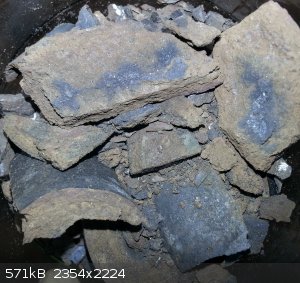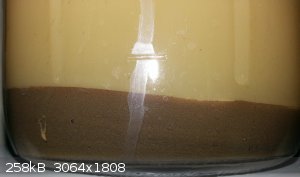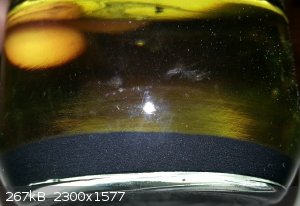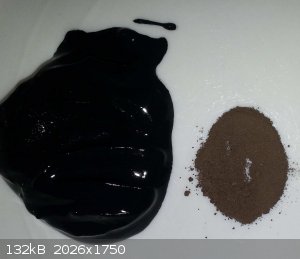RogueRose
International Hazard
    
Posts: 1594
Registered: 16-6-2014
Member Is Offline
|
|
Salvaging MnO2 from batteries really isn't worth it (dirty) - getting pottery grade worth it!
On many occasions I've seen people post about using the MnO2 from alkaline batteries and not only is it a major PITA to get out of the steel case,
then separate the inner ZnO layer and not contaminate it, I've found that there are a ton of impurities in the dioxide, one of the most difficult to
remove being ultra fine graphite (may not be in all brands). I had 160g of MnO2 I had turned into a dust, so super fine. Placing in a 1L glass jar
and then filling with hot water & mixing with a Dremel with the blade from an old stick blender (this is the BEST for mixing & breaking up
particles/clumps). Then heat to boiling, allow to sit for 30-90 mins, then scrape the graphite floating at the top and deposited on the just above
water line, pour off water into gallon jug(s) & repeat starting with filling with hot water, mixing, heating etc. I've done this at least 10
times and there still seems to be the same amount of graphite floating each time and the water I pour off is the light tan.
I have about 3 gallons of liquid I poured off that I am allowing to settle but there really isn't much MnO2 in it. I'm assuming that it also has the
most of the KOH, and any other electrolyte that is present (maybe ZnCl2 or NH4Cl??).
I've also tried cleaning the MnO2 by powdering and boiling in large SS pot (20qt for 1lb of powder) and it creates a foam like elephant toothpaste
that takes forever to "pop" and turn back to liquid, which is just a light brown solution of something, probably the electrolytes. This process also
almost ruins the SS pot as the MnO2 permanently binds to it and needs to be sanded off or LOTS of elbow grease with a SS scrubby - major bitch work!.
Better bet is a ceramic coated aluminium pot (corning makes these, they are very thick & heavy near cast iron) as these clean up easily just don't
boil the water off and burn the MnO2 onto the pot!!
No matter how many times I've tried to extract the graphite, it just always seems to be more there and this stuff is so much finer than ultra fine
Activate carbon, so it seems to pass through filters easily.
I've found some pottery suppliers that offer fairly high purity (they say it is ~97%) for $2.85 for 325 mesh and $3.30 for granular (IDK what size
granular). most other places are a little more expensive at about $3.75 and $4.50 for the mesh/granular respectively from other vendors.
One of the most difficult parts is getting the MnO2 from its pressed form (cylindrical battery) into a usable form that can be cleaned. Some is
pressed EXTREMELY hard and even a 4lb sledge hammer wasn't breaking up pieces! This process took about 1/2 my time in the whole process and I would
sift (fine tea strainer) to remove larger pieces and then smash some more.
All in all, this is very work intensive and if you are ever planning on doing anything with MnO2 and are ordering from a place that has this for a
fair price, I suggest you go that route instead of the battery route. I'm all up for salvaging what I can and go over-board in many cases, but this
one is one that taught me a lesson and angered me. It also creates a MAJOR mess and the MnO2 stains and it a bi-otch to clean up.
Good learning experience only if I can save some others the headaches I have encountered from this process.
BTW, I've tried 3 different Duracell models, Energizer, EverReady, Fuji and 3-4 other brands, and they were all a major PITA, none were easier than
another.
If anyone has any different experiences or has a way around the graphite problem that might be interesting. Now if you plan on cooking the MnO2 with
powdered charcoal to reduce to MnO, then maybe these could work for that...
PS - I haven't messed with the Zn paste (I'm guessing it's ZnO??) too much other than once and it is a real mess to work with and it seems like even
less fun than working with the MnO2. If anyone has experience with this, I'm interested as well as I have 16 F cell batteries (which are 1.5x as tall
as D's & same diameter) and if the Zn could be useful I'm somewhat interested (though I have 50+ lbs of Zn metal)
|
|
|
Melgar
Anti-Spam Agent
    
Posts: 2004
Registered: 23-2-2010
Location: Connecticut
Member Is Offline
Mood: Estrified
|
|
Yeah, when I realized that KMnO4 could be had OTC for about $10/lb, that pretty much did it for me. Just about anything will turn KMnO4 into MnO2.
Hell, I bet you could get higher-purity MnO2 by literally pissing in KMnO4 and filtering it, than you could from batteries. 
The first step in the process of learning something is admitting that you don't know it already.
I'm givin' the spam shields max power at full warp, but they just dinna have the power! We're gonna have to evacuate to new forum software!
|
|
|
DavidJR
National Hazard
   
Posts: 908
Registered: 1-1-2018
Location: Scotland
Member Is Offline
Mood: Tired
|
|
Re MnO2 stains: a solution of sodium bisulphite makes them vanish almost instantly. Very useful for the inevitable mess.
|
|
|
NEMO-Chemistry
International Hazard
    
Posts: 1559
Registered: 29-5-2016
Location: UK
Member Is Offline
Mood: No Mood
|
|
Batteries are a rite of passage though 
|
|
|
RogueRose
International Hazard
    
Posts: 1594
Registered: 16-6-2014
Member Is Offline
|
|
I just came across my first lantern battery that had carbon rods. In 15+ years I've never seen a battery with carbon rods in it and these are the E
or F cell which are 1.6x taller than D's but same diameter. The odd thing is that they have a totally black powder packed around them, which I've
looked at and it seems to be MnO2. It looks nothing like any other brown battery MnO2 I've found and it does decomp H2O2 but not as vigerously as the
brown stuff. It kind of stains like MnO2 but I'm wondering if it isn't carbon powder. I'm still cleaning it and will try some tests.
I know some batteries are zinc carbon, but I thought the carbon was the rod and the zinc was the outer casing (that's what the diagram shows). The
carbon MnO2 batteries show a carbon rod and the standard MnO2 packing like alkaline batteries.
Has anyone come across pure black MnO2 or might I be dealing with carbon here or maybe a mix of carbon and MnO2??
|
|
|
Melgar
Anti-Spam Agent
    
Posts: 2004
Registered: 23-2-2010
Location: Connecticut
Member Is Offline
Mood: Estrified
|
|
Yeah, carbon-zinc batteries don't mention the MnO2, even though that's what they are by weight mostly. Any battery marked as "heavy duty" will have a
zinc case, carbon rods, and MnO2 as the oxidizer. The reaction involves MnO2 oxidizing zinc, albeit indirectly.
And yeah, if you want carbon rods from batteries, those lantern cells are the way to go.
The first step in the process of learning something is admitting that you don't know it already.
I'm givin' the spam shields max power at full warp, but they just dinna have the power! We're gonna have to evacuate to new forum software!
|
|
|
LearnedAmateur
National Hazard
   
Posts: 513
Registered: 30-3-2017
Location: Somewhere in the UK
Member Is Offline
Mood: Free Radical
|
|
My first electrodes (such a milestone) were from a lantern battery - didn’t know what the black crap surrounding them was so that immediately went
in the bin, but to be honest I probably wouldn’t have known what to do with it anyway since I didn’t know it was MnO2 - just that it made my hands
black for days!
About MnO2 though, I’ve collected it from KMnO4 oxidisation reactions and it can come out either as black or brown. I don’t think there is much
contamination which leads to it, it could just be some sort of allotrope, at least a mixture that leans one way or another?
In chemistry, sometimes the solution is the problem.
It’s been a while, but I’m not dead! Updated 7/1/2020. Shout out to Aga, we got along well.
|
|
|
RogueRose
International Hazard
    
Posts: 1594
Registered: 16-6-2014
Member Is Offline
|
|
So I finally got my pics transfered (damn phone!) and there are some good pics of the difference between the MnO2 compositions.
This is the MnO2 from a Duracell and Enegizer battery (D cells) - standard "alkaline)

This is a solution of the MnO2 that I'm trying to "wash" anything out of the oxide. It seems to get the muddy cloudy color no matter how many
washings I do.

This is the same MnO2 as above but I added some H2SO4 to try to make MnSO4 then found that don't work, then added HCl which is supposed to convert it
to the chloride and then sulfate insitu. Notice how much darker the particles are on the bottom

The stuff on the left is from the lantern battery (Eveready Lantern) that had the carbon rods. The black was the same amount as the brown in other
batteries, but just different color. It seemed hard packed but once removed turned into powder very easily - never seen a compacted powder transition
like that before - only about 5% clumps after slight breakup. The right is the duracell MnO2 powdered - not washed.

|
|
|
Melgar
Anti-Spam Agent
    
Posts: 2004
Registered: 23-2-2010
Location: Connecticut
Member Is Offline
Mood: Estrified
|
|
I wonder if you could just heat the battery stuff to red-hot in air? The graphite and hydrocarbons would all burn away, and I'd assume the Mn would
oxidize to MnO2 in the presence of air. You'd have to be really careful of course, and start with small amounts, but it seems like it could work.
The first step in the process of learning something is admitting that you don't know it already.
I'm givin' the spam shields max power at full warp, but they just dinna have the power! We're gonna have to evacuate to new forum software!
|
|
|
woelen
Super Administrator
        
Posts: 8014
Registered: 20-8-2005
Location: Netherlands
Member Is Offline
Mood: interested
|
|
Don't mess with batteries if you want to do some serious chemistry. The MnO2 from batteries may be useful for some pyro-experiments or certain types
of thermite (also pyro-like), but if you want to do some aqueous manganese chemistry, then forget about this crap.
Many people use very impure chemicals, giving inconsistent and hard to interpret results. Of course, I can imagine this, I myself also used impure
chemicals in the past from hardware stores, batteries, cleaners, fuels and whatever one can find, but if you have decent alternatives, then use those.
For MnO2 there are decent alternatives. From pottery suppliers you sometimes can find good quality MnO2, but eBay also is your friend in this case.
MnO2 is not watched or otherwise suspicious, so no fear is needed if you order some online.
Especially if you are a beginner, then it would be best if you use pure chemicals. For beginners it may be hard to recognize an impurity. An example
from my own history.
I once recovered nickel from some piece of metal, I was given. It was fairly pure nickel, better than 95%. I dissolved this in nitric acid and
obtained a nice green solution. I was happy with that. One day, I used that green solution in redox experiments with Na2S2O8. I obtained a bright
pink/purple solution. Very nice, and also very puzzling. I spent hours in the library (those were pre-internet times) but could not find anything.
Later I found out that the piece of junk I used has quite some manganese in it and under the conditions of my experiment part of this was oxidized to
MnO4(-). After this bad experience I decided use OTC-chemicals only very selectively. Some are good (such as NaOH, Na2CO3, NaCl, ligroin, acetone, HCl
for some purposes, ether, ethanol, IPA), but others are really bad and impure (MnO2 from batteries, NaHCO3 (contains a lot of NaCl), moss-remover
FeSO4, Fe from nails). I still have quite some OTC chemicals, but I am aware of their low quality and only use them for specific purposes (e.g. the
impure NaHCO3 always is fine for making a lot of pure CO2 and the FeSO4 is fine for making pure NO in combination with NaNO2).
|
|
|